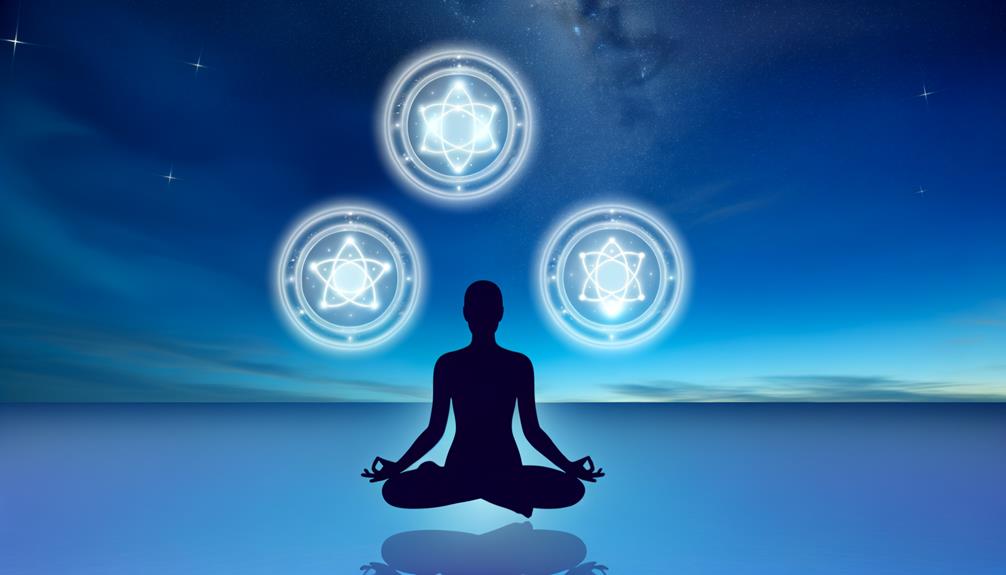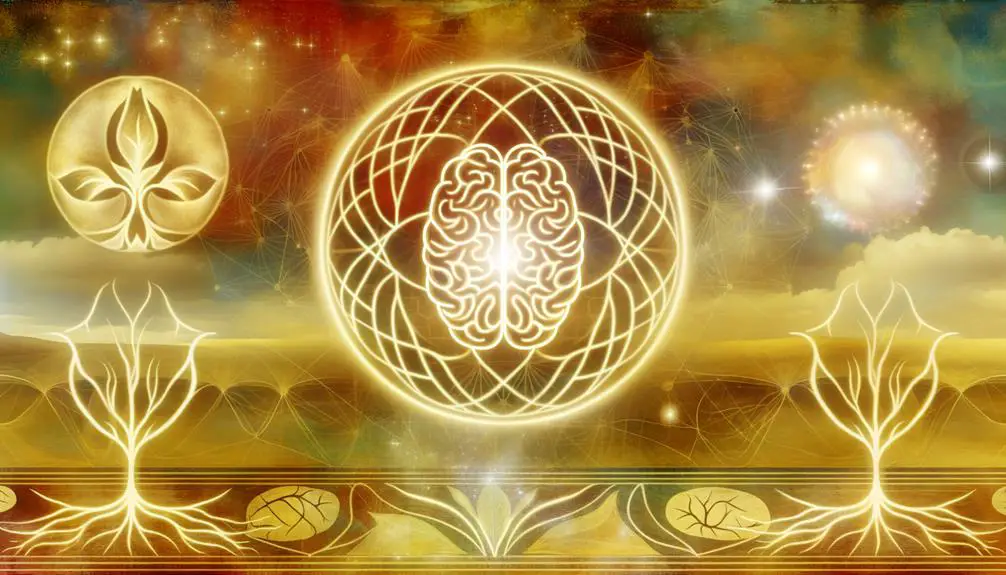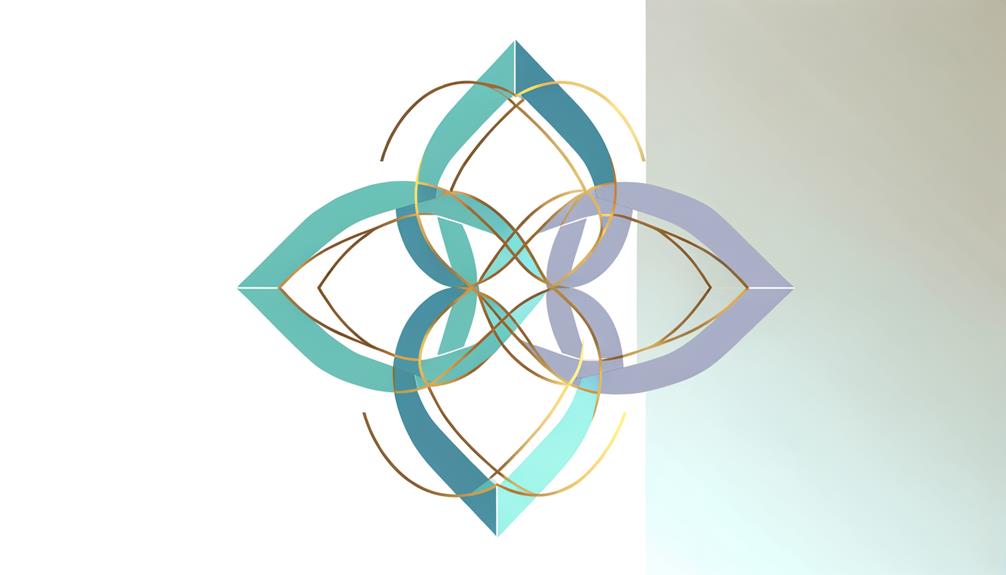What Is the Symbol for Mind Body and Soul?
The mind, body, and soul symbol, rooted in ancient civilizations, signifies the interconnected essence of holistic well-being. It underscores the alignment of physical health, mental clarity, and spiritual fulfillment.
Modern interpretations integrate scientific insights with holistic practices such as mindfulness meditation, nutritional awareness, and spiritual rituals. This symbol not only highlights the importance of balance and harmony but also serves as a guide for daily practices that enhance overall well-being.
Understanding the synergy of these elements offers profound benefits for mental resilience, emotional stability, and physical strength. Exploring further reveals deeper insights into achieving balance and harmony in life.

Key Takeaways
- The symbol represents the interconnectedness of physical health, mental clarity, and spiritual fulfillment.
- It originates from ancient civilizations and is depicted in their art and philosophy.
- Modern designs use geometric shapes, color theory, and cultural motifs to convey holistic well-being.
- The symbol emphasizes achieving balance and harmony in life for overall wellness.
- It aligns with contemporary wellness practices like mindfulness meditation, nutritional awareness, and spiritual exercises.
Origins of the Symbol

The origins of the mind-body-soul symbol can be traced back to ancient civilizations, where it was often depicted in art and philosophy as a representation of holistic well-being. These early depictions underscore a profound understanding of the interconnectedness between physical health, mental clarity, and spiritual fulfillment.
Modern interpretations align with this ancient wisdom, emphasizing the importance of balance among these three elements for peak health. Scientifically, this triad is supported by evidence showing how mental stress can affect physical health and how spiritual practices can enhance mental resilience.
Practically, integrating mindful practices, regular physical activity, and spiritual reflection into daily routines can foster a balanced and harmonious life. Understanding this symbol can hence guide individuals towards complete well-being.
Ancient Cultural Significance
Exploring the ancient cultural significance of the mind-body-soul symbol reveals its pivotal role in shaping holistic health practices and philosophical teachings across diverse civilizations.
In ancient Egypt, the concept of a harmonious triad underpinned their medical and spiritual practices, emphasizing the integration of physical, mental, and spiritual well-being.
Similarly, in traditional Chinese medicine, the balance of body, mind, and spirit, often depicted through the Yin-Yang symbol, was essential for achieving overall health.
Ancient Indian Ayurveda also stressed the interconnectedness of these elements, advocating for a balanced lifestyle to maintain harmony.
These ancient insights underscore the importance of a unified approach to health, offering timeless wisdom that continues to influence contemporary wellness philosophies.
Modern Interpretations

Modern interpretations of the mind-body-soul symbol integrate scientific insights with holistic approaches, offering practical advice for achieving all-encompassing well-being. This contemporary perspective emphasizes the interconnectedness of mental, physical, and spiritual health.
To foster this harmony, consider these three key practices:
- Mindfulness Meditation: Enhances mental clarity and reduces stress, promoting cognitive and emotional equilibrium.
- Nutritional Awareness: A balanced diet fuels the body, supporting physical strength and mental sharpness.
- Spiritual Practices: Engaging in activities like yoga or prayer nurtures the soul, fostering inner peace and purpose.
Each practice underscores the significance of a balanced lifestyle, demonstrating how ancient wisdom and modern science can combine to support holistic well-being.
Symbol Design Elements
Effective symbol design elements for the mind-body-soul concept integrate geometric shapes, color theory, and cultural motifs to convey holistic well-being. Geometric shapes such as circles and triangles can symbolize unity and balance, essential for holistic health.
Utilizing color theory, colors like green, blue, and purple are often chosen for their calming and spiritual associations. Cultural motifs, ranging from ancient mandalas to modern minimalistic designs, imbue the symbol with layers of meaning, fostering a deeper connection to various traditions of well-being.
A scientifically-informed approach ensures that each element harmonizes, creating a cohesive and impactful symbol. Practically, this strategy aids in designing a symbol that resonates universally, promoting a balanced and mindful lifestyle.
Connection to Mindfulness

Mindfulness practices, symbolized through the interconnectedness of mind, body, and soul, play a pivotal role in enhancing present awareness, cultivating inner peace, and strengthening mental clarity.
Scientifically, these practices have been shown to reduce stress and improve cognitive function, offering practical benefits in daily life.
Enhancing Present Awareness
Cultivating present awareness fosters a deeper connection to mindfulness, enabling individuals to navigate daily life with greater clarity and intention. This holistic approach integrates scientific insights to enhance mental well-being. Research reveals that present awareness activates the prefrontal cortex, the brain region responsible for decision-making and emotional regulation.
To practically apply this knowledge:
- Breath Focus: Engage in deep breathing exercises to anchor your awareness in the present moment.
- Sensory Observation: Use your senses to observe your environment, noting colors, sounds, and textures.
- Mindful Reflection: Allocate time for daily reflection to process experiences without judgment.
These practices create a foundation for mindfulness that can be continuously developed, fostering a balanced mind, body, and soul.
Cultivating Inner Peace
Achieving inner tranquility involves balancing the mind, body, and spirit through mindfulness practices that alleviate stress and promote emotional stability. Mindfulness, rooted in ancient traditions, offers scientifically validated methods to reduce anxiety and enhance well-being. Techniques such as meditation, breath regulation, and mindful movement create a harmonious inner environment.
| Mindfulness Technique | Benefits |
|---|---|
| Meditation | Reduces stress, improves concentration |
| Breath Regulation | Enhances relaxation, reduces blood pressure |
| Mindful Movement | Enhances mental clarity, uplifts mood |
| Body Scan | Cultivates self-awareness, eases tension |
Incorporating these practices into daily routines not only nurtures a serene mind but also strengthens the link between physical health and emotional resilience. This holistic approach ensures thorough well-being, crucial for maintaining inner peace.
Strengthening Mental Clarity
Enhancing mental clarity involves adopting mindfulness practices that sharpen focus and foster a deeper sense of awareness. Scientific research underscores the benefits of mindfulness in improving cognitive functions and reducing stress.
To integrate mindfulness effectively:
- Regular Meditation: Devote at least 10 minutes daily to meditation to calm the mind and improve attention span.
- Mindful Breathing: Practice deep, conscious breathing exercises to anchor your thoughts and promote mental clarity.
- Body Scan: Conduct a mental scan of your body to identify and release tension, enhancing your overall awareness.
These methods collectively contribute to a holistic approach, reinforcing the mind's capacity for clarity and presence.
Physical Health Implications
A holistic approach to physical health emphasizes the synergistic effects of regular exercise and balanced nutrition on overall vitality.
Scientific studies consistently show that physical activity boosts energy levels and enhances mental well-being, while proper nutrition plays a pivotal role in maintaining bodily functions and preventing chronic diseases.
Practical advice includes incorporating a variety of physical activities and nutrient-dense foods into daily routines to optimize health outcomes.
Exercise and Vitality Boost
Regular physical exercise plays a pivotal role in enhancing overall vitality and promoting peak physical health. Scientifically, exercise improves cardiovascular health, boosts immune function, and elevates mood through endorphin release.
For best benefits, consider the following:
- Cardiovascular Activities: Engage in activities like running, swimming, or cycling to strengthen the heart and lungs.
- Strength Training: Incorporate weightlifting or resistance exercises to build muscle mass and improve bone density.
- Flexibility and Balance: Practices such as yoga or tai chi enhance muscle flexibility and joint stability, reducing injury risk.
Nutrition's Role in Wellness
Complementing the benefits of physical exercise, proper nutrition is fundamental in supporting overall wellness and optimizing physical health.
A balanced diet rich in fruits, vegetables, lean proteins, and whole grains provides essential nutrients that fuel bodily functions, bolster the immune system, and enhance energy levels.
Scientific research underscores the importance of micronutrients—vitamins and minerals—in preventing chronic diseases such as diabetes and heart disease.
Integrating omega-3 fatty acids, antioxidants, and fiber into daily meals contributes to cardiovascular health and digestive efficiency.
Practical advice includes mindful eating, staying hydrated, and moderating sugar and salt intake.
A well-rounded nutritional strategy not only fortifies the body but also harmonizes the mind, fostering a holistic approach to lifelong wellness.
Spiritual Meaning

Understanding the spiritual meaning of the mind, body, and soul symbol requires a holistic approach that integrates scientific insights with practical wisdom. This symbol serves as a framework to align our physical, mental, and spiritual dimensions, leading to all-encompassing well-being.
Here are three key aspects to contemplate:
- Interconnectedness: Recognize that the mind, body, and soul are interdependent; nurturing one positively impacts the others.
- Balance: Aim for equilibrium among these elements to foster harmony in life.
- Purpose: Use the symbol as a guide to discover and fulfill your deeper life purpose.
Integrating the Symbol Daily
Integrating the Mind Body and Soul symbol into daily routines can greatly enhance personal well-being.
Begin by incorporating the symbol into morning rituals to set a positive tone for the day.
Conclude with evening reflection practices to foster a sense of closure and mindfulness.
Through consistent application, one can harness the holistic benefits of this powerful symbol.
Morning Rituals Incorporation
Incorporating the mind, body, and soul symbol into your morning rituals can greatly enhance your holistic well-being by promoting a balanced start to each day. Scientific studies confirm that morning routines set the tone for mental clarity, physical energy, and emotional stability.
To integrate the symbol effectively:
- Mindfulness Meditation: Begin with a 5-minute meditation focusing on the symbol to align your thoughts and intentions.
- Physical Movement: Engage in yoga or stretching while visualizing the symbol to synchronize body and spirit.
- Affirmations: Recite affirmations that embody the symbol's essence, nurturing a positive mindset.
Such practices encourage a unified approach, enhancing cognitive function, physical health, and emotional resilience, thereby ensuring a harmonious start to your day.
Evening Reflection Practice
A nightly reflection practice centered around the mind, body, and soul symbol can foster a deeper sense of holistic well-being and personal insight.
Scientifically, engaging in mindful reflection activates neural pathways associated with emotional regulation and self-awareness.
To integrate this symbol into your evening routine, begin by setting aside ten minutes in a quiet space. Focus on each aspect—mind, body, and soul—individually.
Reflect on mental achievements, physical sensations, and emotional experiences of the day.
Documenting these reflections in a journal can provide tangible evidence of personal growth over time.
This practice not only enhances self-understanding but also promotes a balanced state of inner harmony, preparing you for restorative sleep and a more centered existence.
Benefits of Holistic Balance

Achieving a harmonious balance between mind, body, and soul offers profound benefits that enhance overall well-being and foster resilience against life's stressors. This holistic approach is supported by scientific insights, which indicate that such equilibrium can lead to improved mental health, physical strength, and emotional stability.
Practically, individuals can experience:
- Enhanced Cognitive Function: Mental clarity and focus are heightened, resulting in better decision-making and problem-solving abilities.
- Increased Physical Health: Regular holistic practices contribute to reduced stress levels, lower blood pressure, and stronger immune responses.
- Emotional Resilience: A balanced state fosters emotional intelligence, enabling more effective coping mechanisms and a positive outlook on life.
Personal Transformation Stories
Many individuals have shared compelling personal transformation stories, illustrating the profound impact of achieving a harmonious balance between mind, body, and soul.
One such story involves a person combating chronic stress through mindfulness practices. Scientifically, mindfulness can reduce cortisol levels, fostering mental clarity and emotional resilience.
Another narrative reveals a journey of physical rehabilitation, where the integration of yoga and nutrition notably improved overall health. This holistic approach ensures that physical well-being is supported by mental and spiritual wellness.
Additionally, personal growth in spirituality, often achieved through meditation or community engagement, has shown to enhance life satisfaction and purpose.
These stories collectively underscore the transformative potential of a balanced lifestyle, offering practical insights for those seeking holistic harmony.
Embracing the Symbol's Wisdom

Understanding and embracing the wisdom embedded within the mind, body, and soul symbol can offer profound guidance for achieving holistic well-being. This ancient emblem encourages a balanced approach to health by integrating three crucial dimensions of human existence.
- Mental Clarity: Engaging in mindfulness practices and cognitive exercises enhances mental sharpness and emotional resilience.
- Physical Vigor: Regular physical activity, balanced nutrition, and adequate rest foster a strong and dynamic body.
- Spiritual Fulfillment: Deepening one's spiritual practice, whether through meditation, prayer, or community engagement, can cultivate inner peace and purpose.
Scientific studies affirm that a synergistic approach, addressing these three dimensions, leads to improved overall health. By consciously integrating these elements into daily life, individuals can experience a more harmonious and enriched existence.
Conclusion
In summation, the mind, body, and soul symbol, with origins as ancient as human curiosity itself, continues to captivate modern minds. Revered by those seeking holistic balance and scorned by skeptics as mere mythological ornamentation, its design elements and applications to mindfulness offer both profound and trivial insights.
Embracing this symbol daily, one might achieve the elusive holistic harmony, or at the very least, provide fodder for the next wellness retreat brochure.






